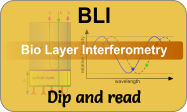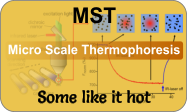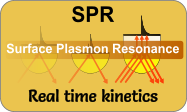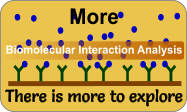Introduction
The BIApages are a roundup of the most common methods and techniques to investigate Biomolecular Interaction Analysis. Central are the methods which determine when and how biomolecules interact. You can think of the association and dissociation but also thermodynamics and conformational changes in molecules and complexes. The techniques are not necessarily label- or immobilization free.
Label- or immobilization free?
There are only a few really label- and immobilization free techniques which are able to measure biomolecular interactions. One of the most used is Isothermal Titration Calorimetry (ITC). The technique is simple to perform but needs quite some sample. Other techniques require that at least one component is immobilized to a supporting structure or sensor surface.
Of this category, Surface Plasmon Resonance (SPR) and Bio Layer interferometry (BLI) are the most common used. The sample consumption with SPR type instruments vary on the design but are moderate to low. BLI however uses very low quantities of the sample which can be recovered after the experiment. For Micro Scale Thermophoresis (MST) one of the interactants must be labelled (although there is a complete label-free instrument). This method uses very low amounts of sample and is relatively fast compared to SPR and BLI.
There are many techniques to explore bio molecules and their interactions. Some are both label- and immobilization free, other require labelling or immobilization. In the table is a round-up of techniques used in the study of bio molecules with an indication of the main information that can be obtained.
|
|
Technique | Immob. | Label | Information |
|---|---|---|---|---|
| SPR | Surface Plasmon Resonance | yes | no | kinetic |
| BLI | Bio-Layer Interferometry | yes | no | kinetic |
| MST | Micro Scale Thermoforesis | no | yes/no* | equilibrium |
| ITC | Isothermal Titration Calorimetry | no | no | equilibrium |
| AUC | Analytical Ultra Centrifugation | no | no | equilibrium |
| Microbalance / Cantilever | yes | no | ||
| AFM | Atomic Force Microscopy | yes | no | |
| High Performance capillary electrophoresis | no | ? | equilibrium | |
| LFII | Label-Free Intrinsic Imaging | |||
| NMR | Nuclear Magnetic Resonance | structural | ||
| Electron Diffraction | structural | |||
| Electron Microscopy | structural | |||
| FRET | Fluorescent Energy Transfer | yes | equilibrium | |
| Size exclusion chromatography | no | no | size / dimer | |
|
* Depending on the type of instrument. |
||||
Label free techniques
Roundup of the websites and suppliers I found that do measurements in non invasive ways on non labelled molecules.
| Company | Technique |
|---|---|
| MicroCal | VP-ITC system which uses differential scanning calorimetry. |
| Axela Biosensors | Diffractive optics technology with grating-based light diffraction and immobilized capture surfaces. |
| Q-Sense | The quartz crystal microbalance consists of a thin quartz disc with electrodes on both sides. The resonance frequency depends on the attached mass that is oscillating. A viscoelastic film will dampen the oscillation. |
| BioForce Nanosciences | Atomic-force-microscopy-based platform for nanoarray analysis. |
| DeltaDot | High performance capillary electrophoresis with label-free intrinsic imaging using algorithms to identify biomolecules. |




